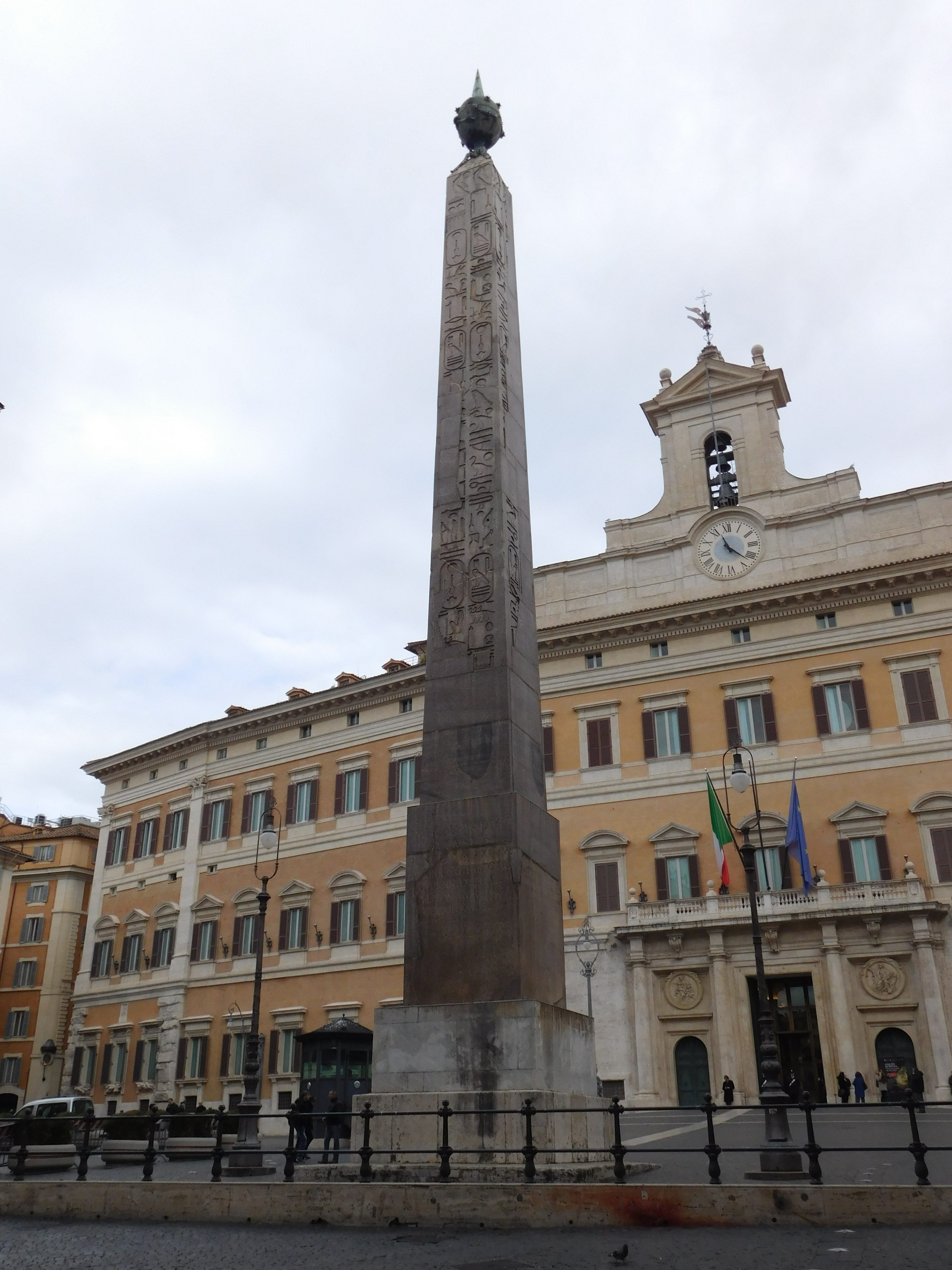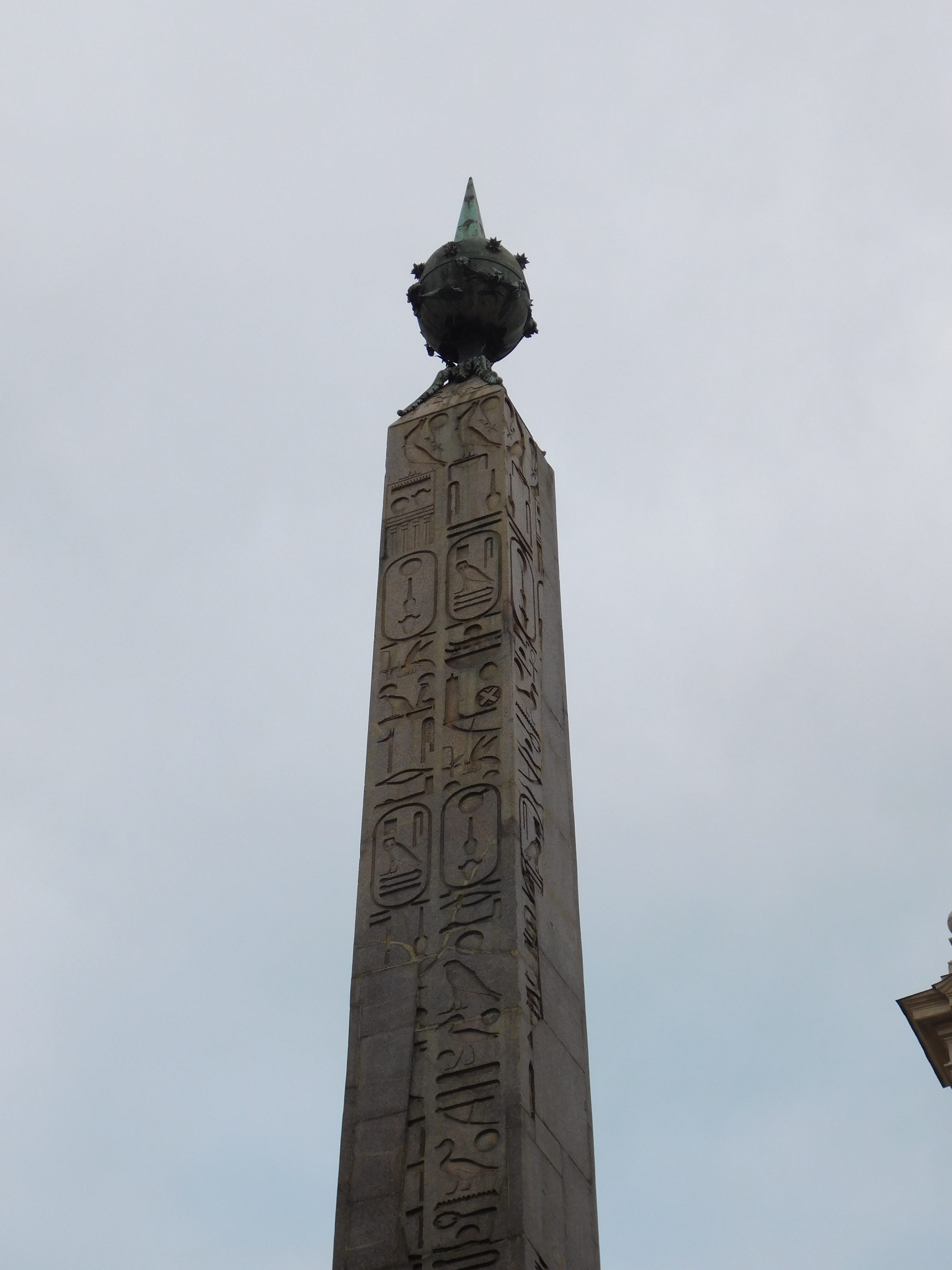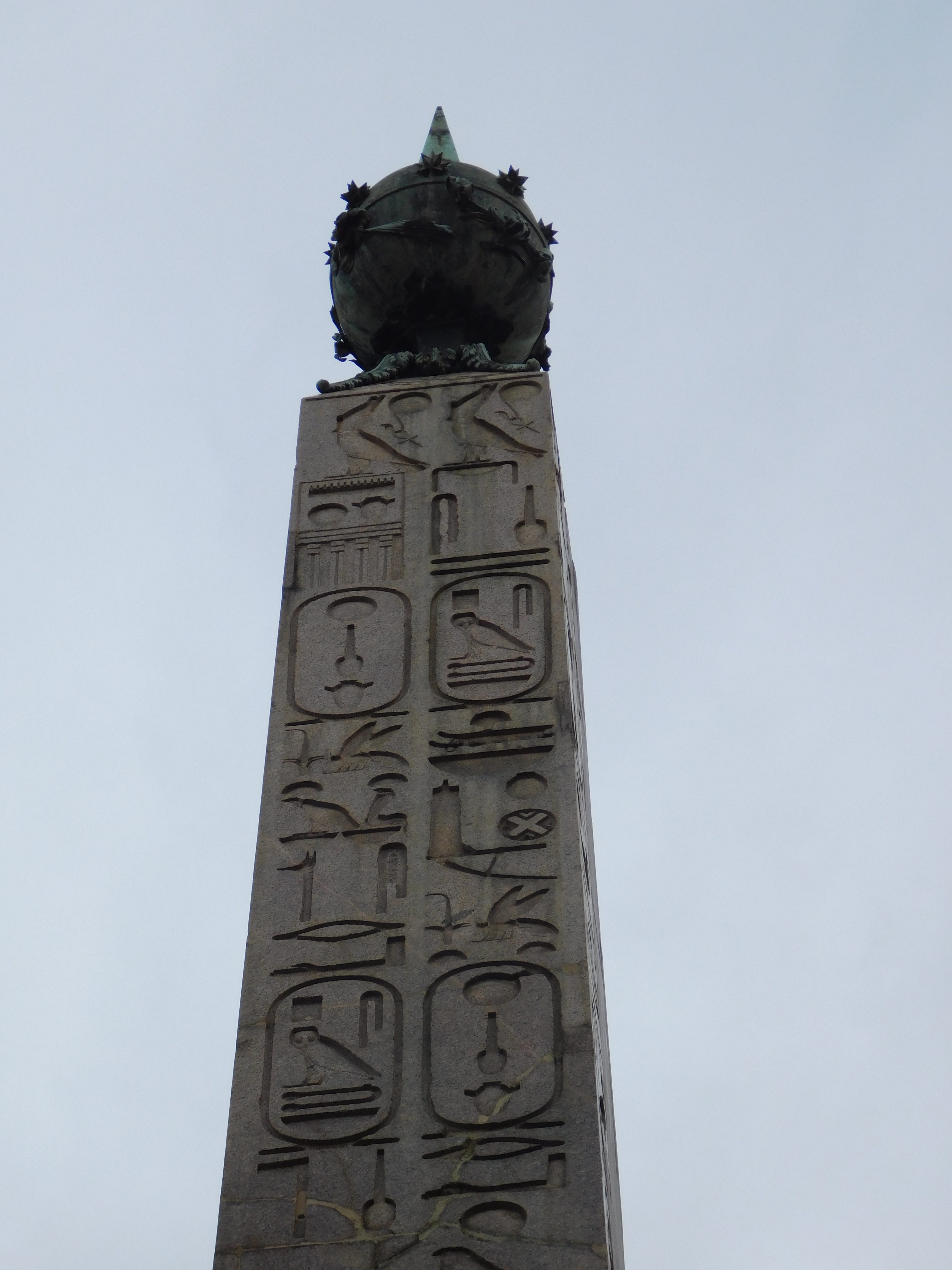The month’s blog is brought to you by Jade Coates. Jade is a postgraduate student studying at the University of Kent and explores whether the Horologium Augusti was really a sundial.
The Horologium Augusti is a monument bringing together Roman, Egyptian, and Greek influences as a display of imperial power and divinity. It served a practical purpose as a Horologium, but more importantly it was a representation of political, religious, and scientific power.
Image: Obelisk of the Horologium Augusti in the present Piazza di Montecitorio (Source: Amy Bradshaw)
The obelisk of the Horologium Augusti was originally placed in Heliopolis, Egypt, as one of an identical pair. Erected by Psametik II (594-589 BCE), it served as a dedication to the sun god Re and a monument of triumph. Pliny the Elder comments, ‘An obelisk is a symbolic representation of the sun’s rays, and this is the meaning of the Egyptian word for it’ (Natural History 36.14). Pliny was right as tekhen means both ‘sunbeam’ and ‘obelisk’!
The obelisk remained in Heliopolis until 10 BCE, when Augustus had it relocated to the Campus Martius in Rome. Monuments signifying triumph are commonplace in Rome. The obelisk was one of the earliest monuments in Rome made of rose granite, meaning it would have been even more prominent in the landscape due to its unusual colour. During Augustus’ reign, he restricted laws around triumphal monuments so only the imperial family could erect them.
Initially, the use of an obelisk in Augustus’ Horologium seems to be nothing more than a display of triumph over Egypt; the battle of Actium had taken place 20 years earlier and would have been fresh in the memory of the public. Simply the act of removing the obelisk from its original Egyptian context and moving it to Rome shows the power Augustus could exhibit over Egypt now it was under his control. The obelisk would have served as a reminder for the people of Rome of their glorious expanding empire, and the great leader who was in command. Its sheer magnitude would have been astounding, with some predictions suggesting that it once stood at nearly 22 metres. By using a foreign object as a symbol of triumph, it is a display of the glory of the empire and all it had to offer.

Image: The Horologium Augusti (Source: Amy Bradshaw)
The display of triumph was not restricted to the obelisk itself. The act of bringing it into the city would have been a triumphal procession, with Pliny the Elder stating that the ‘ships used attracted much attention from sightseers’ (Natural History 36.70). New naval technology was required to transport the obelisk. Based on the double hulled ships used by the Egyptians to transport obelisks down the Nile, the Romans created a triple hulled ship better suited for the greater distance and open sea. The two peripheral hulls supported the obelisk itself, whilst the central hull drove through the waves. Pliny comments, that the ship ‘which carried the first of two obelisks was solemnly laid up by Augustus in the permanet dock at Pozzuoli to celebrate the remarkable acheivement’ (Natural History 36.70).
It would have sailed up the Tiber on barges before unloading the colossal obelisk, which would then be transported through the streets of Rome using ox carts and pulleys until it reached the Campus Martius. The act of moving such a large and heavy monument would have undoubtedly attracted attention, and people would have lined the streets to watch the exotic monument go past.
There is a sense of one-upmanship in the movement of the obelisk, with Augustus effectively saying “anything you can do I can do better” to the Egyptians. After all, the Egyptians had ‘simply’ moved their obelisks from the quarries in the North of Egypt downriver to their destination, Heliopolis. They even transported the obelisks in an undecorated state, to account for minor damage that may occur en route. However, Augustus had to transport the obelisk across the Mediterranean and preserve it intact. Pliny notes that the third obelisk transported to Rome, by Caligula and Nero, ‘was the only one of the three that was broken during its removal’ (Natural History 36.74).
The transport of the obelisk was a conspicuous display of power, one that emphasises the strength of Rome over Egypt. The obelisk was erected onto a base of the same rose granite imported from Egypt, mimicking the obelisk itself. Not only did this give a seamless fusion of Egyptian and Roman stonework, rose granite was an inherently Egyptian material that would have only been available at the outskirts of the empire. This would suggest to anyone viewing the monument that Augustus had the wealth of the empire at his fingertips; nothing was too great a task. However, it was not simply to display power. The use of an Egyptian material in a Roman fashion gives a sense of unity, with the empire being a cohesive unit as opposed to a tumultuous relationship between countries. The matching obelisk and base was a visual metaphor of harmony.
This rose granite base was inscribed in Latin, in contrast to the hieroglyphs on the obelisk itself. The inscription stated “Caesar Augustus, imperator, son of a divus, pontifex maximus, imperator twelve times, consul eleven times, with tribunician power fourteen times. With Egypt having been brought into the domain of the Roman people, Augustus gave this gift to the sun” (Swetnam-Burland, 2010; 135). Augustus himself is closely linked with the sun, stating himself to be the son of Apollo; a god with solar significance (Younger and Rehak, 2006; 93). Within Egypt, as well as being erected for the sun god Re, obelisks were meant to symbolise sun rays (Swetnam-Burland, 2010; 139). Upon being moved to Rome, Augustus placed the obelisk in an explicitly solar context; a Horologium. In using a monument devoted to the sun in his own dedication, Augustus reaffirms his right to rule and divine solar kingship.
The hieroglyphic inscriptions were also in translation slightly to give a more Roman meaning. Translated in Ammianus Marcellinus’ Res Gestae (17.4), the general meaning of the obelisk is conveyed despite the author having read the hieroglyphs entirely in the wrong order. Crucially, one word translated with an interesting, and likely deliberate choice of word. In place of the hieroglyph for ‘Upper and Lower Egypt’, it is written as oikoumene, meaning the entirety of the civilised and inhabited world. Now, instead of stating that the monument was erected to show power over the whole of Egypt, it stated power over all civilised nations. However, the emphasis on power over both Upper and Lower Egypt was due to reunification of Egypt around the time of Psametik II. The emphasis of the inscription was triumph in unification, and so whilst the translation specifies triumph over the civilised world it may again be in the context of unification as opposed to brute power. The hieroglyphs themselves were not changed but this did not matter, the average Roman citizen would have been unable to read the hieroglyphs and would instead rely on translations if they wished to know what it read.

Image: Augustus’ inscription on the base of the Horologium (Source: Amy Bradshaw)
The obelisk was also a monument of rebirth. When the obelisk was moved to Rome, Heliopolis had already fallen into ruin (Strabo, Geography 17.1.27). A symbol of triumph, splendour, and power, it was born from a place of disrepair and decay. It proved that Augustus was not simply a conqueror of lands, but someone to restore glory and light to the places brought into the empire. Whether the peoples of the conquered lands agreed was irrelevant, this was a monument for the people of Rome.
The Horologium was a triumph of Egyptian architecture, Roman engineering, and Greek science. Whilst not the first Roman Horologium, it was the first to be built on such a scale. This scale was necessary if it fulfilled a secondary purpose in relation to its surrounding monuments. It appears that the Horologium was not a monument to be viewed in isolation, its placement within the Campus Martius was key to its function. It was theorised that on the days surrounding the Autumn equinox, which would have included Augustus’ birthday, the shadow of the Horologium would have pointed directly to the Ara Pacis.

Image: Brass globe on the top of the Horologium (Source: Amy Bradshaw)
Under Augustus’ orders, the mathematician Novius Facundus had a brass globe placed at the summit; signifying the empire and giving a stronger shadow at the tip. As Pliny notes, ‘He [Novius] placed on the pinnacle a gilt ball, at the top of which the shadow would be concentrated, for otherwise the shadow cast by the obelisk would have lacked definition. He is said to have understood the principle from observing the shadow cast by the human head’ (Natural History 36.72).

Image: The top of the Horologium (Source: Amy Bradshaw)
This direct link between a monument of triumph, the Horologium, and a monument of peace, the Ara Pacis, is an interesting one. The Horologium would not have been possible without Augustus winning the battle of Actium. But by linking a monument that has an inherent basis in war with a tribute to peace, Augustus is showing just how successful an emperor he was. Whilst to us it may sound similar to the idea of ‘bombing for peace’, Augustus in fact fought to re-stabilise the empire after the volatility brought about by his predecessor, Julius Caesar. Through fighting, he proved himself as a ruler who should not be underestimated, and then shifted focus towards peace.
Further Reading
Ammianus Marcellinus, Trans. Rolfe, J.C., 1950. Res Gestae. Loeb Classical Library
Beck, R., 1994. ‘Cosmic Models: Some Uses of Hellenistic Science in Roman Religion’. Apieron, 27(4);
99-118
Buchner, E., 1976. ‘Solarium Augusti und Ara Pacis’. Römische Mitteilungen 83; 319-365
Campbell, B., 2002. War and society in imperial Rome 31 BC – AD 284. London: Routledge Press
Curran, B.A., Grafton, A., Long, P.O., and Weiss, B., 2009. Obelisk: A History. Cambridge: MIT Press
Heslin, P., 2007. ‘Augustus, Domitian and the So-Called Horologium Augusti’. The Journal of Roman Studies, 97; 1-20
Pliny the Elder, Trans. Rackham, H., Jones, W.H.S., and Eichholz, D.E., 1963. Natural History. Cambridge: Harvard University Press
Schutz, M., 1990. ‘Zur Sonnenuhr des Augustus auf dem Marsfeld: Eine Auscinandersetzung mit E. Buchner’s Rekonstruktion und seiner Deutung des Ausgrabunsergebnisse, aus der Sicht eines Physikers’. Gymnasium, 97(43); 432-457
Strabo, Trans. Jones, H.L., 1960. The Geography of Strabo. Cambridge: Harvard University Press
Swetnam-Burland, M., 2010. ‘‘Aegyptus Redacta’: The Egyptian Obelisk in the Augustan Campus Martius’. The Art Bulletin, 92(3); 135-153
Wallis Budge, E.A., 1926. Cleopatra’s Needles and Other Egyptian Obelisks. New York: Dover Publications Inc.
Wirschin, A., 2000. ‘How the Obelisks reached Rome: Evidence of Roman Double-Ships’. International Journal of Nautical Archaeology, 29; 273-283
Wirschin, A., 2002. ‘Die Obelisken auf dem Seeweg nach Rom’. Mitteilungen des Deutschen Archäologischn Instituts, 109; 141-156
Younger, J.G., and Rehak, P., 2006. Imperium and cosmos: Augustus and the northern Campus Martius. Madison: University of Wisconsin Press
